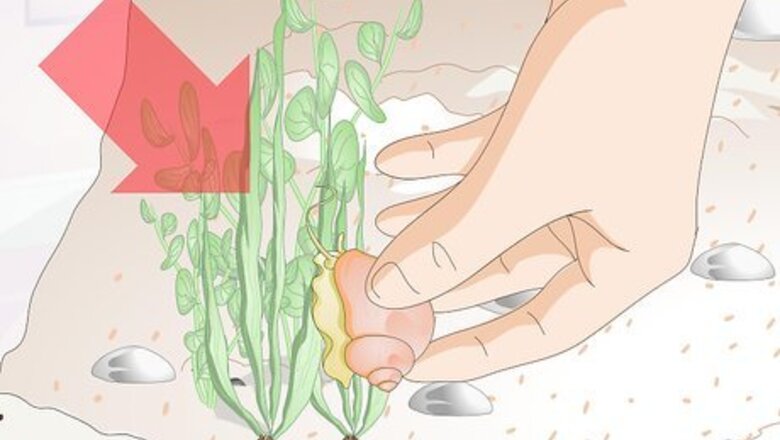
views
Caring For Your Snail
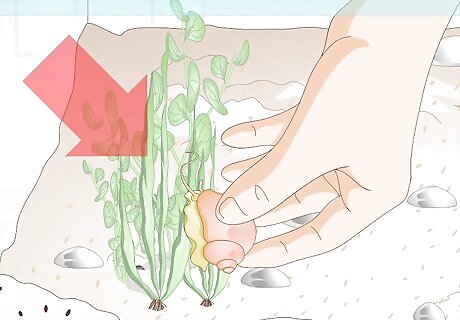
Provide your snail with food. One of the biggest needs your snail will have is adequate food. If your snail doesn't have enough food it will go hungry, but with too much food the water quality will quickly deteriorate. Most snails enjoy having plants in the tank to graze on. They also eat algae, whether it is found naturally on the tank's walls or provided in the form of store-bought algae wafers. Some experts recommend feeding aquatic snails as much food as those snails can consume in under three minutes, twice daily. This will require some trial and error, so make adjustments accordingly. As a general rule, if you provide supplemental food to your snail and it hasn't touched that food in two days, you may be feeding it too much/often. It could also indicate that your snail does not care for that food source, so try different options and gauge your snail's response. Talk to a qualified aquarium expert at your local pet store or at a local college/university to ensure that your snail gets the care it needs.
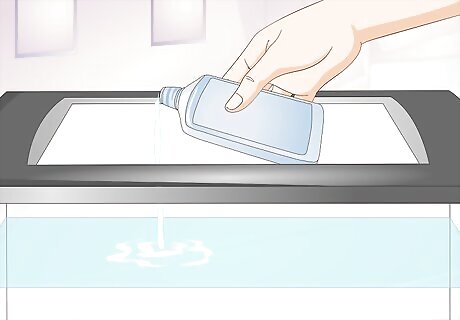
Treat tap water before using it. Many municipal water supplies use chemicals like chlorine to treat tap water, which can be deadly to snails (though it's safe for humans to drink). Bottled water will help ensure a safe, neutral water source for your snails, but it can get very costly. Some snail owners with access to an outdoor freshwater source also opt for fresh pond water. Snails need a stable, neutral pH. You can buy pH testing kits at your local pet store, or order them through an online retailer. If you cannot use bottled water or pond water, you can simply let the tap water you'll be pouring into the tank sit out in an open container for 24 hours. This should allow the residual chemicals to evaporate, leaving behind a safe source of water for your aquarium.
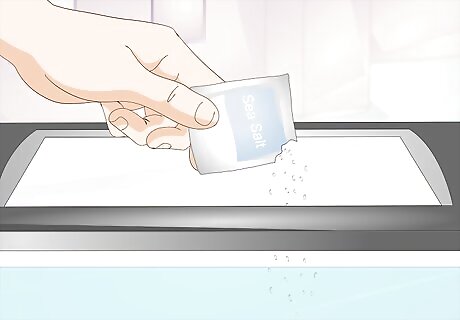
Prepare the water for saltwater snails. If you plan on caring for saltwater snails, you will need to prepare a suitable environment for those snails. Preparing saltwater for marine snails is no different than preparing saltwater for a tank of any other marine creatures, such as saltwater fish or corals. The biggest thing you'll need is a special salt mixture, as household salt cannot be added to water to create a marine environment. Test your tap water for nitrates. You can purchase a water testing kit from your local pet store or through an online retailer. Use purified water if your tap water is high in nitrates, as this water may not be safe for aquatic invertebrates. Common methods of purifying tap water are reverse osmosis, deionization, and ion exchange. Purchase an aquarium salt mix from your local pet store or online. Mix approximately 35 grams of salt mix per liter of water to closely replicate natural sea water. Consider purchasing a salinity measurement kit to ensure that your salt to water ratios are stable. Most aquarium owners who measure salinity use either a hydrometer (typically the least expensive option), a refractometer, or an electronic salinity meter.
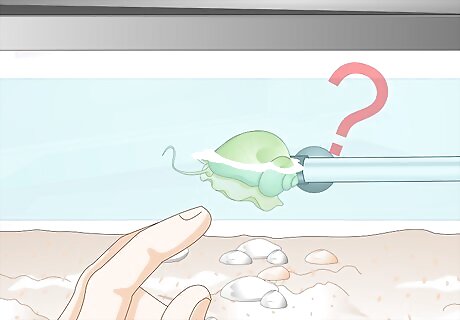
Make sure your snail is still alive. Some common snail behaviors often result in owners wondering whether the snail is still alive. The best way to care for your snail is to check up on it periodically, especially if you notice it acting strangely. Snails often float to the surface of an aquarium, leading some owners to think that the snail is dead. It's simply got a gas bubble temporarily stuck under its shell, and the problem will resolve itself over time. Some snails withdraw into their shells, which owners frequently mistake as a sign of death. This is an incorrect assumption. A dead snail will hang limply outside the shell, while a living snail may retract into the shell. You can check on your snail by gently pushing against the flap where the shell closes. If the shell remains closed and the snail resists your efforts, it is still alive.
Preparing a Habitat For Your Snail
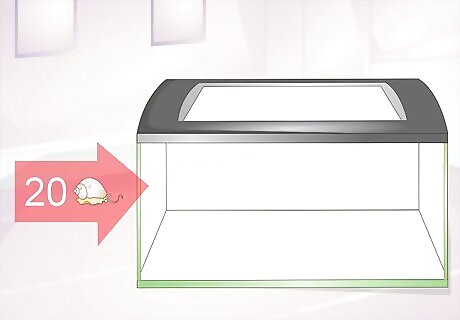
Choose an appropriately-sized tank. The size of your tank will largely depend on how big your snail is, how many snails you have, and whether the snails you've chosen are prone to rapid and large-scale reproduction. Do not exceed 20 snails per one gallon tank. If you don't have a full aquarium tank, you can use a clean quart- or gallon-sized container with transparent walls. It's best if you can see your snails to assess their health, so opt for glass or clear plastic containers when choosing an environment. If using a smaller container, do not exceed three to six snails per quart, depending on their size. Make sure you have a secure lid for your tank (ideally a screen lid that will allow fresh air to circulate through the aquarium). Some snails are notorious for finding ways to escape from their tanks.
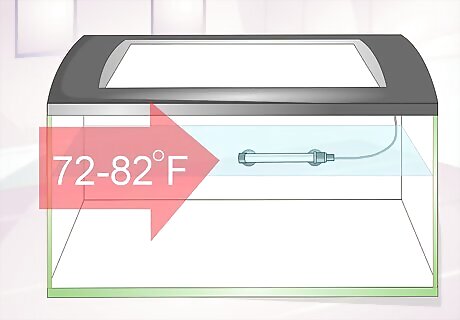
Regulate the aquarium temperature as needed. The ideal water temperature for freshwater snails is between 72 to 82 degrees Fahrenheit (22 to 28 degrees Celsius). Many saltwater snails require similar temperature ranges. The bumble bee snail, for example, does best when the water is between 72 and 78 degrees Fahrenheit (22 to 25 degrees Celsius). Depending on certain environmental factors, like the ambient temperature in your home and the climate you live in, you may need to regulate the aquarium temperature to keep the water within an appropriate range. You can also rearrange the aquarium within your home so that it is in a more stable environment, with an ideal room temperature between 64 to 77 degrees Fahrenheit (18 to 25 degrees Celsius). Keep the aquarium away from direct sunlight to prevent the water from getting too warm during the day. Aquarium heaters are available to warm up the water if you live in a cold climate with poor insulation or inadequate heating, or if it gets too cold at night in your home. You can buy aquarium heaters at most pet stores and through online retailers.
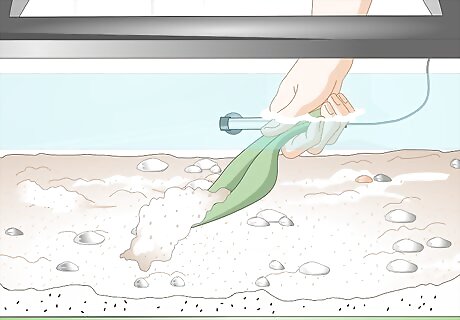
Provide snails with a substrate at the bottom. The bottom of your tank is an important component of a healthy aquarium. Most snails need some type of aquatic plants in the aquarium, which means you'll have to bury the roots in substrate. Many snails also scavenge through the substrate looking for food, so be sure your snail has some type of stable environment available at the bottom of the tank. Sand works best for many varieties of aquatic snail, though some may enjoy digging through gravel. About one or two inches of substrate should be sufficient for most snails. Talk to a qualified aquarium expert at your local pet store to find out about the ideal conditions for the type of snail you're interested in.
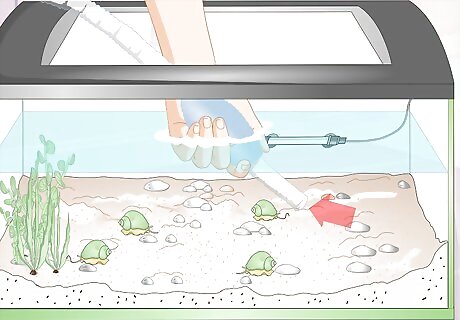
Keep a clean environment. Every aquatic creature needs a clean tank. However, snails are particularly sensitive to their environment. They feed off of algae and decaying plant matter, but they also need clean, fresh water. If your aquarium is left unattended, your snail may not survive for long. Check the water on a regular basis to make sure that none of your snails (or any other aquatic organisms living in your tank) have died. Use a fish net to scoop out any dead organisms from your tank before they begin to decompose. Any time the water becomes murky/cloudy or starts to smell, you'll need to change the water.
Selecting the Right Snail For Your Aquarium
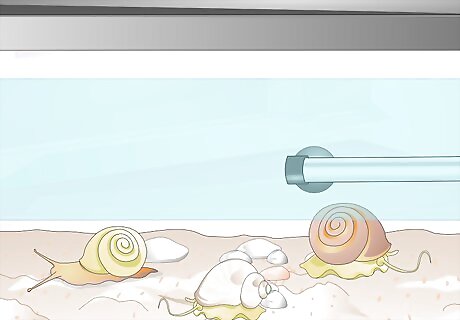
Identify the different types of freshwater snail. There are many different varieties of aquatic snail, though the most common varieties you'll encounter are the Gold Inca, mystery, nerite, pond, ramshorn, and trumpet snails. Each one is marked by its own distinct features. Which snail you choose may depend on your aesthetic preferences, your tank's needs, or both. Gold Inca snails are recognizable by their bright, yellow shells. Gold Inca snails are considered good cleaners of freshwater tanks, as they tend to consume algae and detritus. Ivory snails are identified by their cream-colored shells. Ivory snails are also considered good tank cleaners and "scavengers" of freshwater aquariums. Mystery snails have a shell that tends to vary in appearance, but is usually somewhat dark (though some are ivory), typically with brown accents or stripes. Mystery snails have a tendency to scavenge, but they can also easily escape tanks and will most likely require a secure lid. Nerite snails come in different shapes, colors, and patterns, depending on the variety of snail. Nerite snails tend to scavenge for algae, but they also burrow into the substrate at the bottom in search of food. Pond snails are one of the most frequently-encountered unwanted snails. Pond snails tend to travel on aquatic plants and in aquarium water, often inadvertently making their way home from the pet store to a new home. Ramshorn snails have a shell that appears to twist and curl, much like the horn on the head of a ram (hence the name). Ramshorn snails are good scavengers, but like pond snails they often end up in home aquariums by accident. Trumpet snails tend to have elongated and cone-shaped shells. Trumpet snails are excellent scavengers, but like pond snails and ramshorn snails, they often appear without invitation in new aquariums due to their ability to sneak in on freshwater plants.
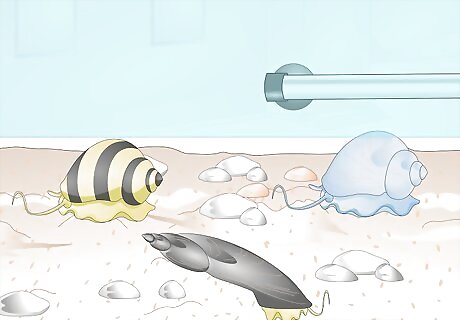
Learn about different varieties of saltwater snails. Saltwater snails are also a popular addition to many marine tanks. They tend to eat algae and plant matter just like freshwater snails do, but some snails are carnivorous. They also tend to be more colorful than their freshwater counterparts. For this reason, many aquarium enthusiasts prefer saltwater snails for their home tanks. Which snail you choose will largely depend on your personal aesthetics and your home aquarium setup. Bumble bee snails are carnivorous invertebrates. They typically eat meat-based detritus, including decomposing organisms in the tank, and have been known to eat other snails in the tank when food is scarce. Cerith snails are easy to care for and can help improve oxygenation within the substrate of an aquarium. They scavenge for algae, detritus, leftover food, and fish waste. Nassarius snails eat detritus, leftover food, decaying plant material, and fish wastes. They are excellent at keeping aquariums clean as they typically seek out a lot of food within the tank. Turbo snails are generally easy to care for and tend to be very colorful. They come in a number of varieties, including Astraea turbo snails and chestnut turbo snails, and they tend to feed on algae and dried seaweed flakes.
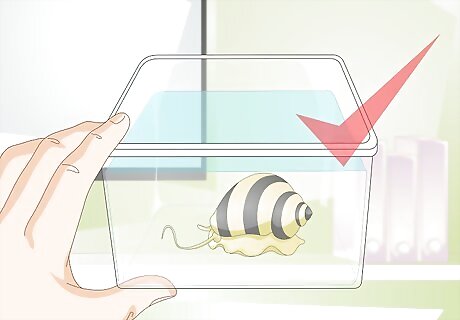
Choose a healthy-looking snail. If you're new to keeping aquatic snails, you may be uncertain about what to look for while selecting a snail. Avoid any snail that exhibits a loss of color, a lack of appetite, an inability to move/exert energy, a tendency to hide inside its shell, or visible spots or other types of fungus anywhere on the body or mouth, as these snails are most likely ill or carrying parasites. When you choose a snail, look for the following signs of good health: active movement within the water a healthy appetite for whatever type of food that snail prefers consistent/evenly-distributed coloring a clean shell
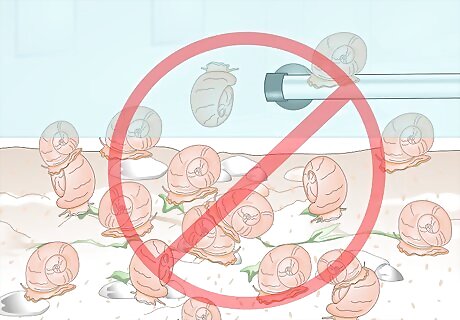
Recognize the risks of certain varieties. It's important to be aware of the risks that come with certain varieties of aquatic snails. Some varieties are considered "pests," appearing unexpectedly and reproducing on a large scale. These population booms can reduce oxygen content in the water, increase the levels of carbon dioxide, and create a great deal of organic waste through their excrement and eventual decomposition. When choosing aquatic snails, it's best to select snail varieties that are not generally considered pests by aquarium owners. Ramshorn snails are considered one of the biggest pest varieties. These snails reproduce quickly and in very large numbers. Pond snails and trumpet snails are also considered pests by many aquarium owners, though some owners select these snails for aesthetic reasons. Talk to an aquarium expert at your local pet store if you're not sure whether a particular variety of snail might become a pest in your tank.

















Comments
0 comment